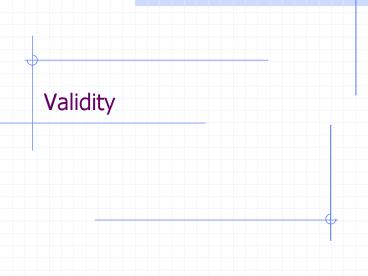Validity - PowerPoint PPT Presentation
1 / 21
Title:
Validity
Description:
... the measure represents all facets for a given construct. ... Useful in that proposed construct should pay its way by doing some work (cf. ... Construct Validity ... – PowerPoint PPT presentation
Number of Views:50
Avg rating:3.0/5.0
Title: Validity
1
Validity
2
Todays Objectives
- What is validity and what are the 4 broad
categories of methods for establishing validity
evidence? - Why is the base rate of the predictor and of the
criterion important considerations in
establishing criterion validity? - Define construct and name the methods for
establishing construct validity - What are some difficulties in interpreting
differences between pre- and post-test scores?
3
Validity
- Validity refers to an estimate of how adequately
a test measures what it purports to measure
4
Validation
- Validity Evidence
- Face Validity
- Content Validity
- Criterion Validity
- Construct Validity
5
Face Validity
- To the person being tested, what does the test
appear to be measuring?
6
Content Validity
- Extent to which the measure represents all facets
for a given construct. - Are the test items representative with regard to
the application context?
7
Criterion-Related Validity
- Extent to which test score can be used to infer
an individuals most probable standing on some
criterion (i.e., measure of interest) - Concurrent versus Predictive
8
Criterion-Related Validity
- Validity coefficient
- Restricted range
- Incremental validity
- Degree to which additional predictor explains
something about the criterion measure that is not
explained by the predictors already in use
9
Criterion-Related Validity
Hit
Miss
False Alarm
Correct Rejection
10
Construct Validity
- Construct Informed scientific idea hypothesized
to describe behavior - Unobservable Presupposed
- Underlies differences in behavior (such as
differences in test performance, or such as
differences on the criterion variable) - Useful in that proposed construct should pay its
way by doing some work (cf. Occams razor,
principle of parsimony)
11
Construct Validity
- Construct Validity
- Degree to which inferences can legitimately be
made from the operationalizations in your study
to the theoretical constructs on which those
operationalizations were based. - Reification Error
- If the only way you can 'prove' the existence of
something is through language, then does that
something exist in reality? Could it be only word
play?
12
Construct Validity
- Construct Validity
- If empirical results are contrary to theory,
then - A. Test does not measure the construct
- B. Theory is flawed
- C. Method was flawed
13
Construct Validity
- Construct Validity Evidence
- Homogeneity
- Age related changes
- Pretest/Posttest changes
- Contrasted groups evidence
- Convergent Evidence
- Discriminant Evidence
- Multitrait-Multimethod Matrix
14
Construct Validity
- Homogeneity
- Item analysis Relationship between test takers
scores on individual items and their score on the
entire test
15
Construct Validity
- Age Related
- Some constructs lend themselves to the prediction
that the construct will change predictably over
time - Reading ability versus marital satisfaction
16
Construct Validity
- Pretest/Posttest
- Compare scores on a pretest with a posttest
17
Construct Validity
- Rival explanations for significant Pre/Post test
differences - Regression toward the mean
- Instrumentation
- History
- Maturation
- Mortality
- Test experience
18
Construct Validity
- Method of Contrasted Groups
- Demonstrates that scores on a test predictably
vary as a function of group membership
19
Construct Validity
- Convergent Validity Correlation of test with
other tests that measure the construct (or
related constructs) - Spurious convergence Positively correlated
measures may be related only because they share
the same method of measurement (i.e., they share
common method variance)
20
Construct Validity
- Discriminant Evidence
- Correlation between test scores and other
measures that should NOT theoretically be related
21
Construct Validity
- Multitrait-Multimethod Matrix (Campbell Fiske,
1959) - Two or more traits, two or more methods of
measurement examined for convergent and divergent
validity - Data for each trait indicator obtained by
multiple methods and/or from multiple sources































